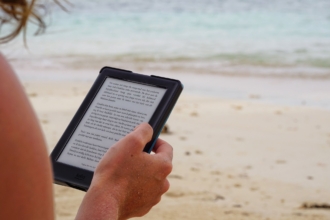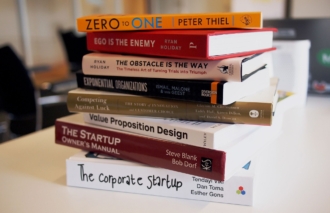“One trouble with developing speed reading skills is that by the time you realize a book is boring you’ve already finished it.” — Franklin P. Jones
I’m a proud book nerd. But I’m not a speed reader. Far from it.
Reading is one of my favorite pastimes. I do it whenever I get the chance: I read on my phone, listen to audiobooks, scan newspapers, and swipe through pages on my Kindle. I read on the subway, over breakfast, and before I fall asleep.
People talk a lot about reading these days — how to read 100 books per year, or how to read 300% faster in just 20 minutes. The overall message: more is better.
But before you download the latest speed reading app or purchase a dozen new books on Amazon, let’s consider: why are we reading in the first place?
If you’re trying to whiz through as many books as possible, then speed read away.
But if your goal is to learn something and truly savor a good book, then it might be time to pump the brakes and focus on reading comprehension.
The modern-day reader
We don’t typically think about the nuts and bolts of reading. But when we read a paragraph or a page, our brain activity is actually pretty incredible — and complex.
Two basic processes happen when we read:
The decoding process translates strings of letters into words. At the same time, language processing, or comprehension, gives meaning to those words and integrates them with our existing knowledge. We put the words and sentences into the larger context of what we’re reading.
If you’re like me, then you read more digital than printed material. Though the basic processes are the same, the physiology of digital reading is different.
Research shows that when people read online, they tend to browse and scan, look for keywords, and read in a less linear, more selective fashion.
In other words, people skim. On the page, they tend to concentrate more on following the text.
When we read digitally, we’re more likely to move quickly, without stopping to reflect. It raises the question: does comprehension suffer when we read on a screen?
Researchers have found that reading printed material, as opposed to digital, may increase reading comprehension. When study participants were asked to place a story’s events in chronological order, those who had read the story in print, as opposed to on e-readers, performed significantly better.
But as the researchers point out, maybe we just need better digital reading skills — especially when comprehension is our goal.
Reading for comprehension
There are two types of reading: passive and active.
Passive reading is the (mostly) mindless scanning we do when we’re scrolling Facebook or browsing a waiting room magazine.
Active reading has a purpose. We engage with the material, ask questions as we go, and consider what we’re reading.
Clearly, true comprehension requires active reading, so here are some tips to help us all become more active readers:
1. Start by identifying your purpose.
Before you dive in, think about why you’re reading in the first place: are you prepping for a meeting? Keeping up on industry news? Learning about a software update? Identifying our purpose helps us to stay on track and avoid mindless scanning. We can target the relevant information and skim over the rest.

2. Remember what you’re reading.
When we read fiction or poetry, we don’t want to miss a single word, because the author has deliberately selected every sentence and paragraph.
When we tackle nonfiction, however, we’re often reading for a less literary purpose, and more to learn the substance of the topic. To read nonfiction titles more efficiently, it might be helpful to…
- Start by learning about the author: read the title, subtitle, front flap, and table of contents to understand the big picture
- Make sure to read the introduction and the conclusion
- Read or skim each chapter for relevant points
- End with the table of contents again
I’d never read a novel this way, but for nonfiction, these techniques can save time and ensure we still retain what we cover.
3. Engage with the material.
While you read, think about the material and ask yourself questions, like, “how does this relate to the author’s larger argument?” and “is the author’s reasoning effective.”
Take notes, both in the margins of the book (called “marginalia”), and in a separate notebook or document.
For increased retention, write a short summary of each chapter you finish, including meaningful passages and phrases. Imagine a stranger who’s never read the book will be borrowing your notes: how would you communicate the most important points?
4. Make mental links.
Here’s where speed reading can do us a disservice. We need time to make mental links — to consider how each concept or idea relates to our current mental library. These links make it easier to recall what we’ve read.
So, if I’m reading a book about creative problem solving, I’ll compare the methods with ideas I’ve gained from another author. This process of linking and analyzing helps to cement the new information in my brain.
5. Reflect and summarize.
Once you finish a book, give yourself time to reflect. You can even write a three-sentence summary of what you’ve learned and come back to it later. This practice forces us to review our notes and reflect on the most salient points.
Writes Robert Greene, author of The 3 Secrets That Help Me Write and Think:
“After I am done reading [a book] I will often put it aside for up to a week and think deeply about the lessons and key stories that could be used for my book project. I then go back and put these important sections on notecards.”
You can write summaries and reflections on notecards, in a journal, or an online document, but make sure they’re accessible and easy to find when you need them.
You are what you read
“I cannot remember the books I have read any more than the meals I have eaten; even so, they have made me.”
We read for many reasons. Actors aside, the purpose of reading isn’t to memorize each line. We read to absorb the text and to change the way we see the world.
As Paul Graham writes in his essay, How You Know:
“Reading and experience train your model of the world. And even if you forget the experience or what you read, its effect on your model of the world persists. Your mind is like a compiled program you’ve lost the source of. It works, but you don’t know why.”
Remembering this quote can eliminate any stress we might feel about reading.
It’s okay if you don’t read 100 books per year.
And it’s fine if you don’t recall every fact or event you encounter. As long as you read actively and engage with the material, chances are you’re taking the book with you.









































































Send Comment:
3 Comments:
More than a year ago
Hello Admin
Absolutely concur with you Aytekin and Mungai. While I appreciate the individuals who can peruse and rapidly assimilate what they need from a book, I'm a more slow peruser, so I'm never going to tear through volumes at an extraordinary rate. Better to appreciate the procedure and retain what you need when you need it than coercively feed data.
Thanks for sharing this article.
Regard
Vinita
More than a year ago
This is very true. Just a While ago, I was reading an argumentative essay online from this site, but I couldn't get what the writer was talking about clearly, simply because I was in a hurry to read. After reading your post and going back to the essay, I fully understood the writer's arguments. Thanks a lot for this piece.
More than a year ago
I completely agree. I think we often rush through the things we read, that it ends up being a task instead of an experience. I got into books much later in life and I am old school at heart. I have to flip pages, underline things, highlight others, make notes and really reflect on lessons learnt. Going through so many books without a break takes that away for me. So now I take my time.
Thanks for this post. Great tips.